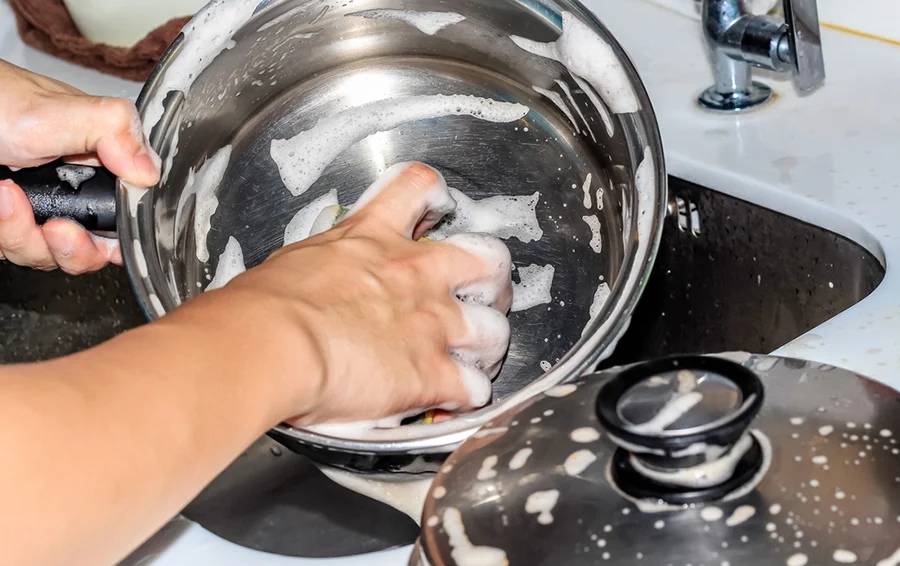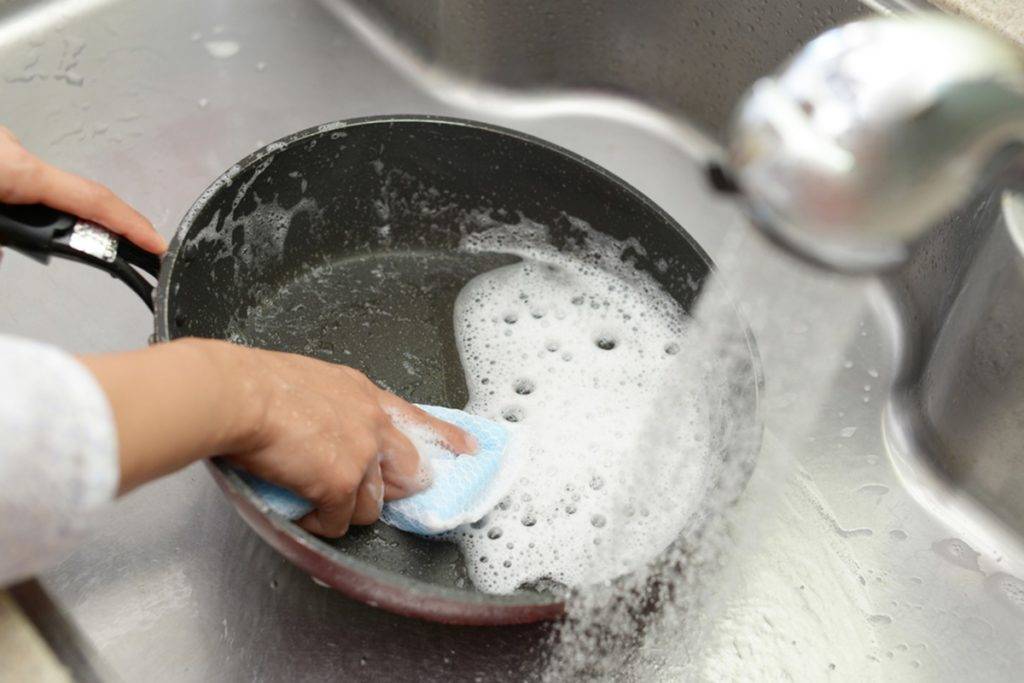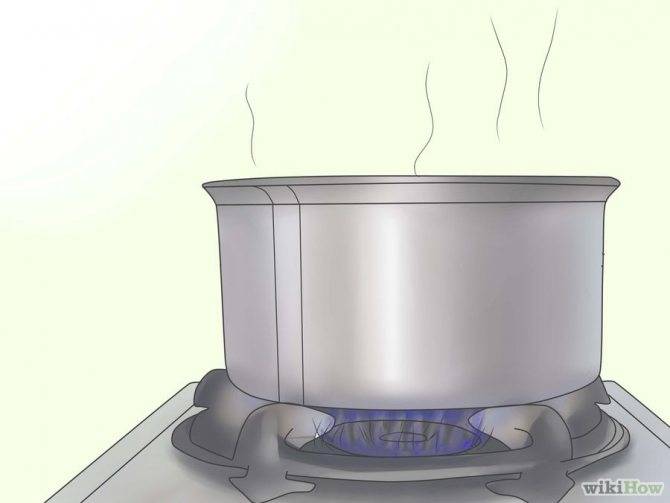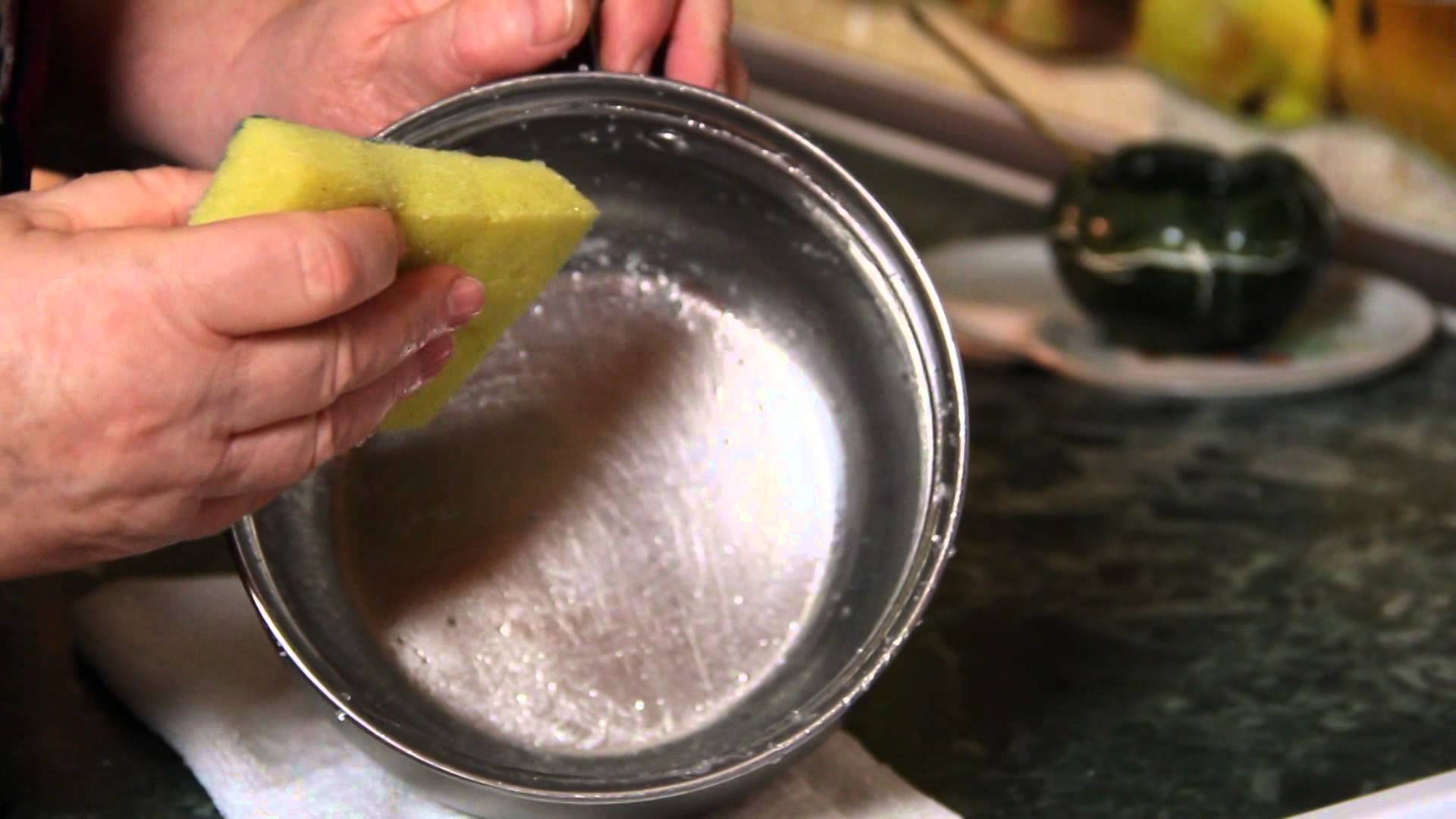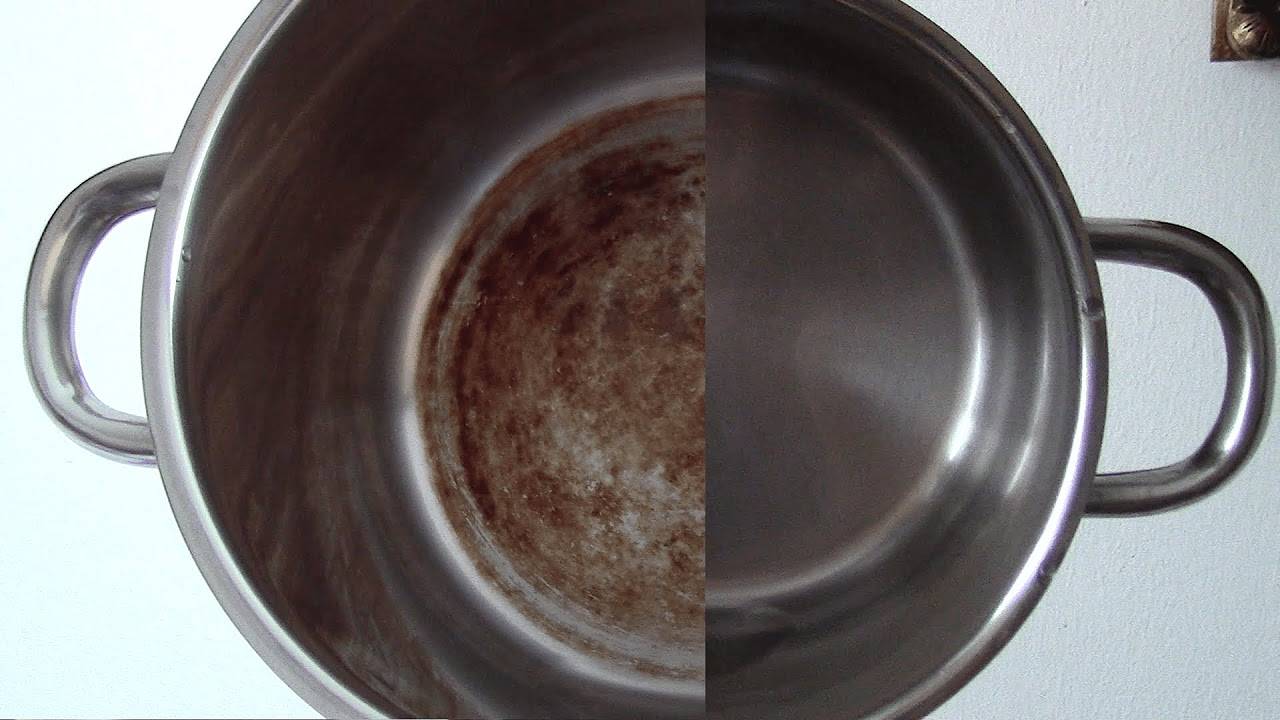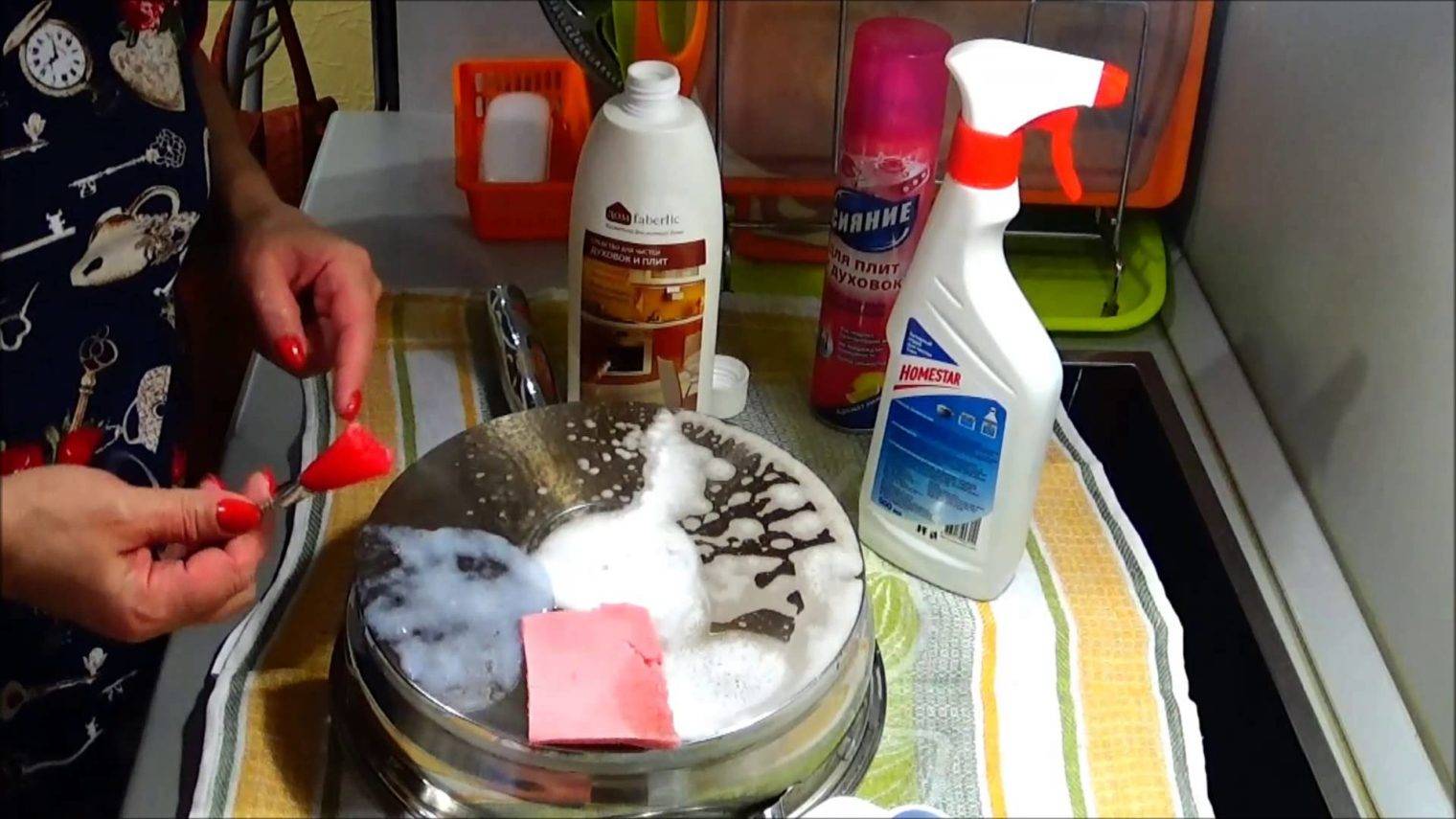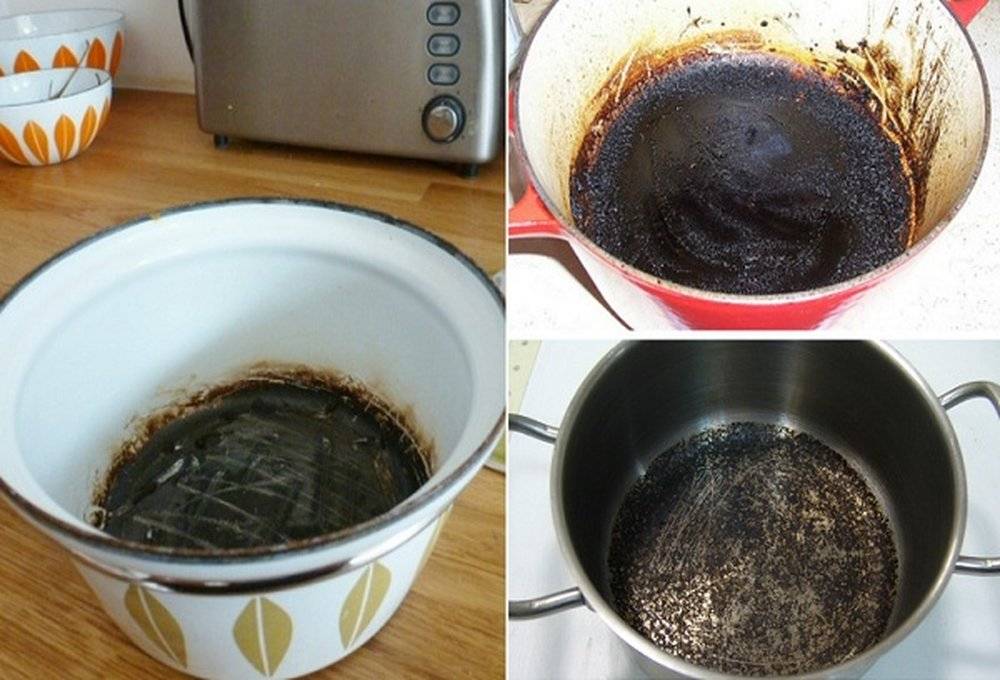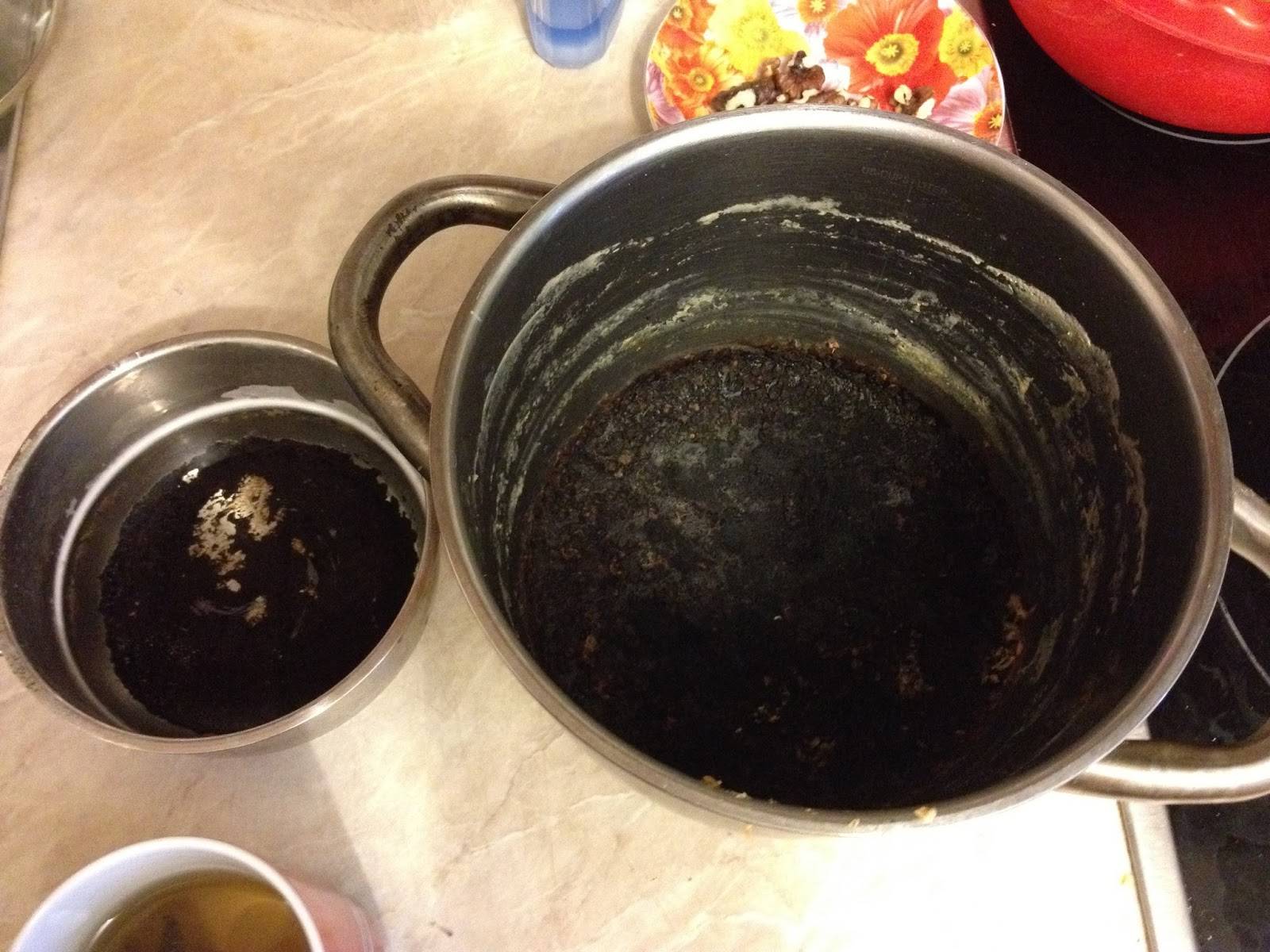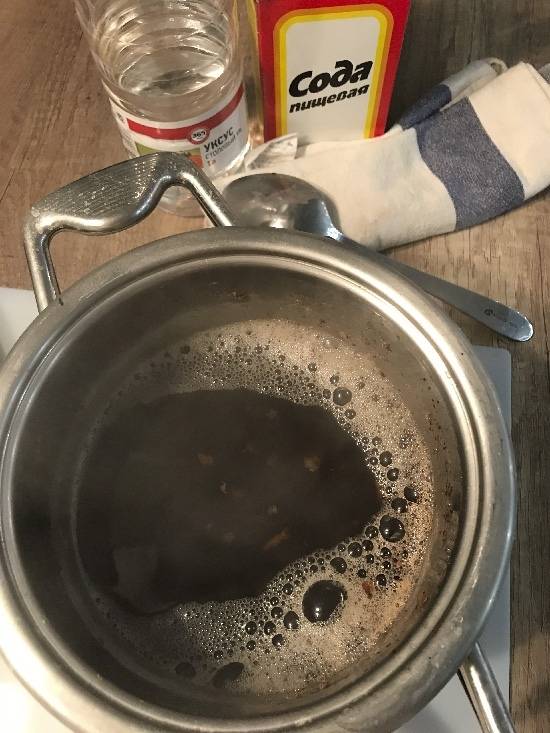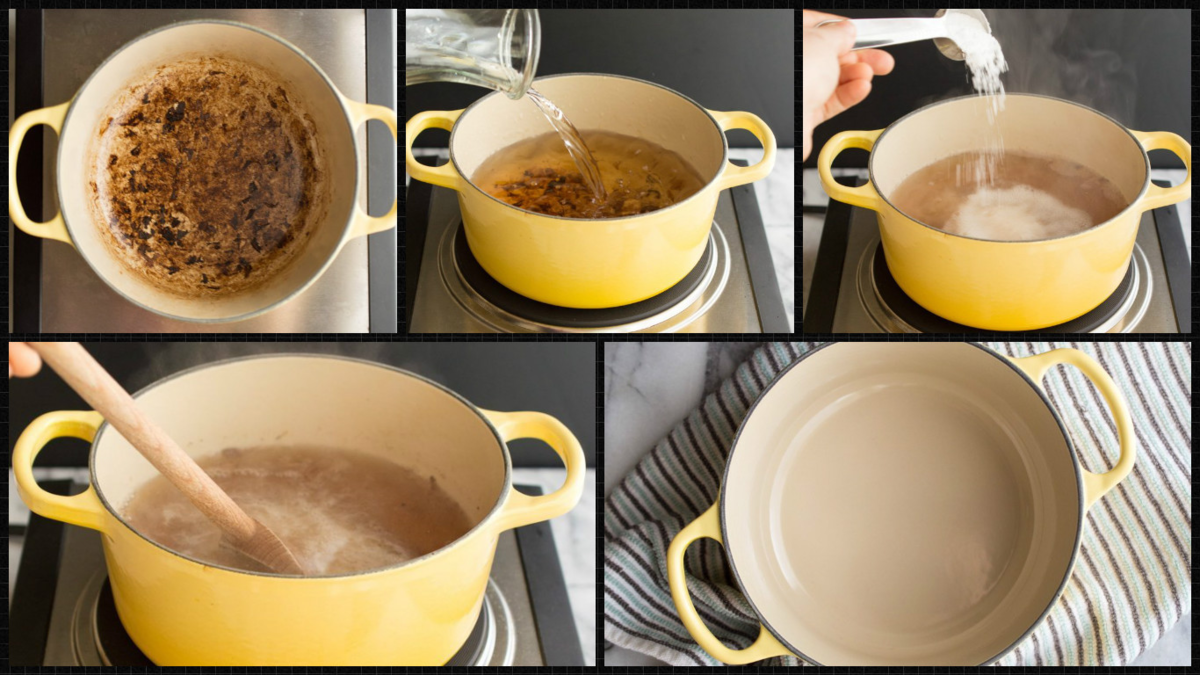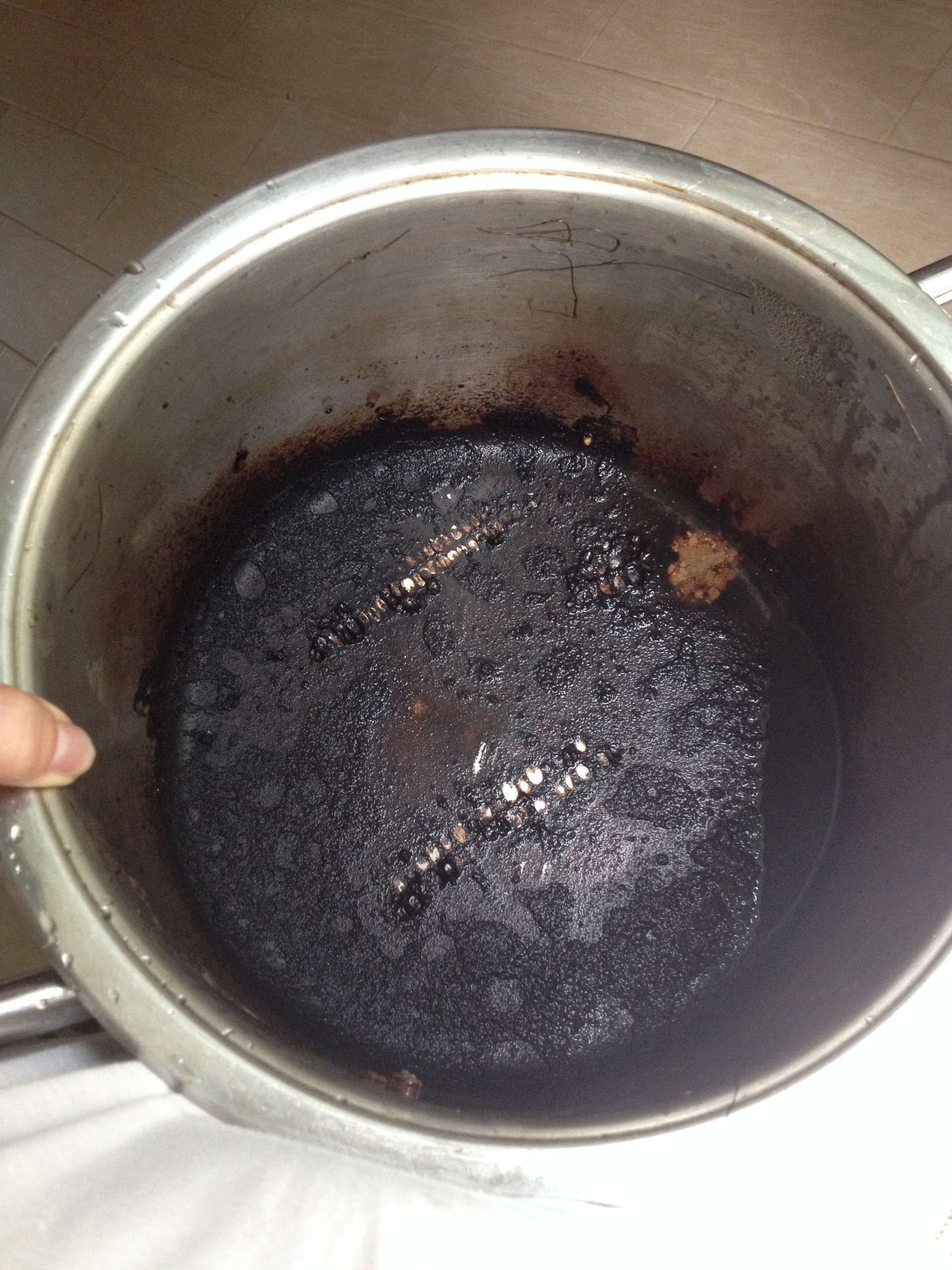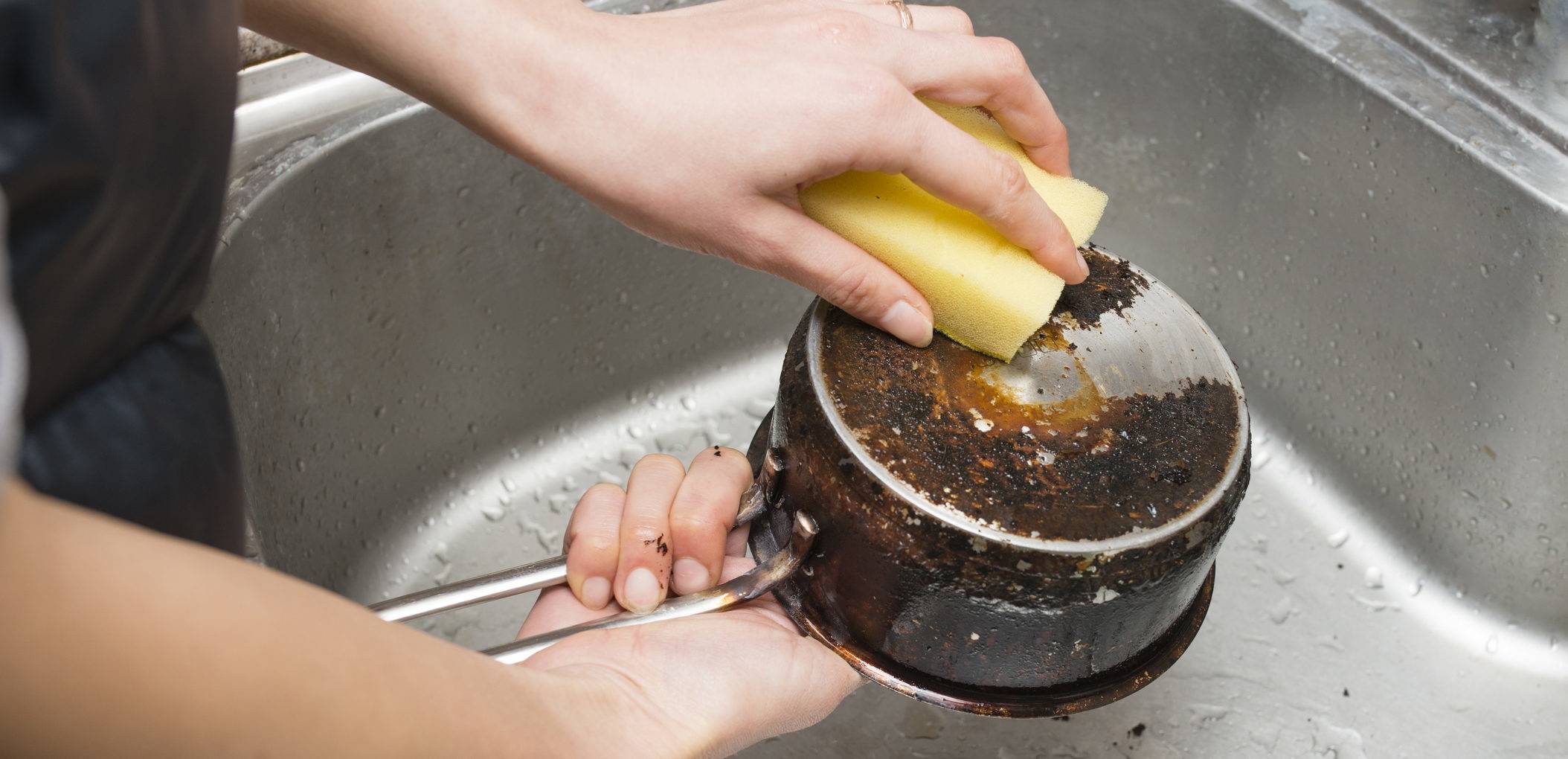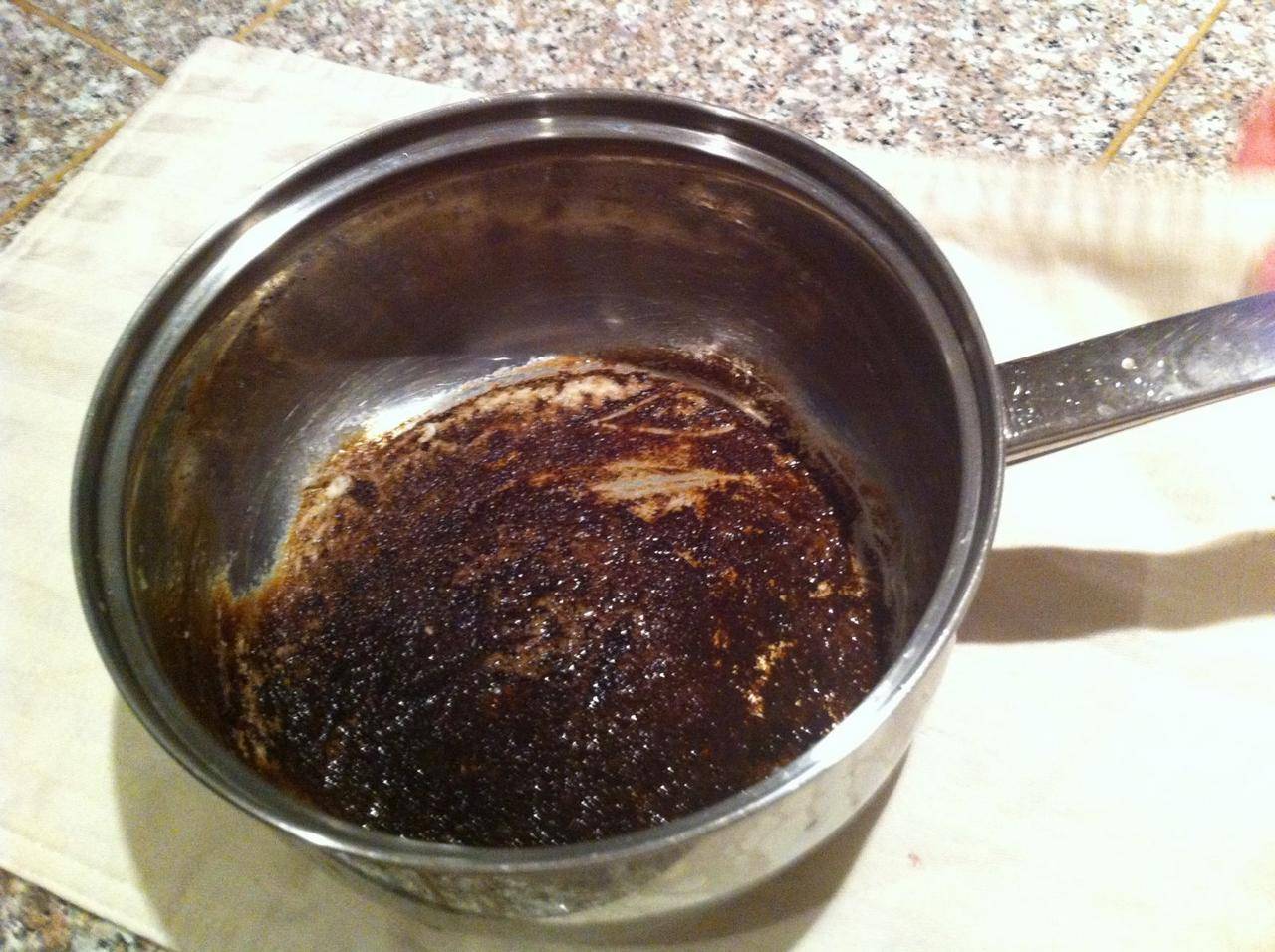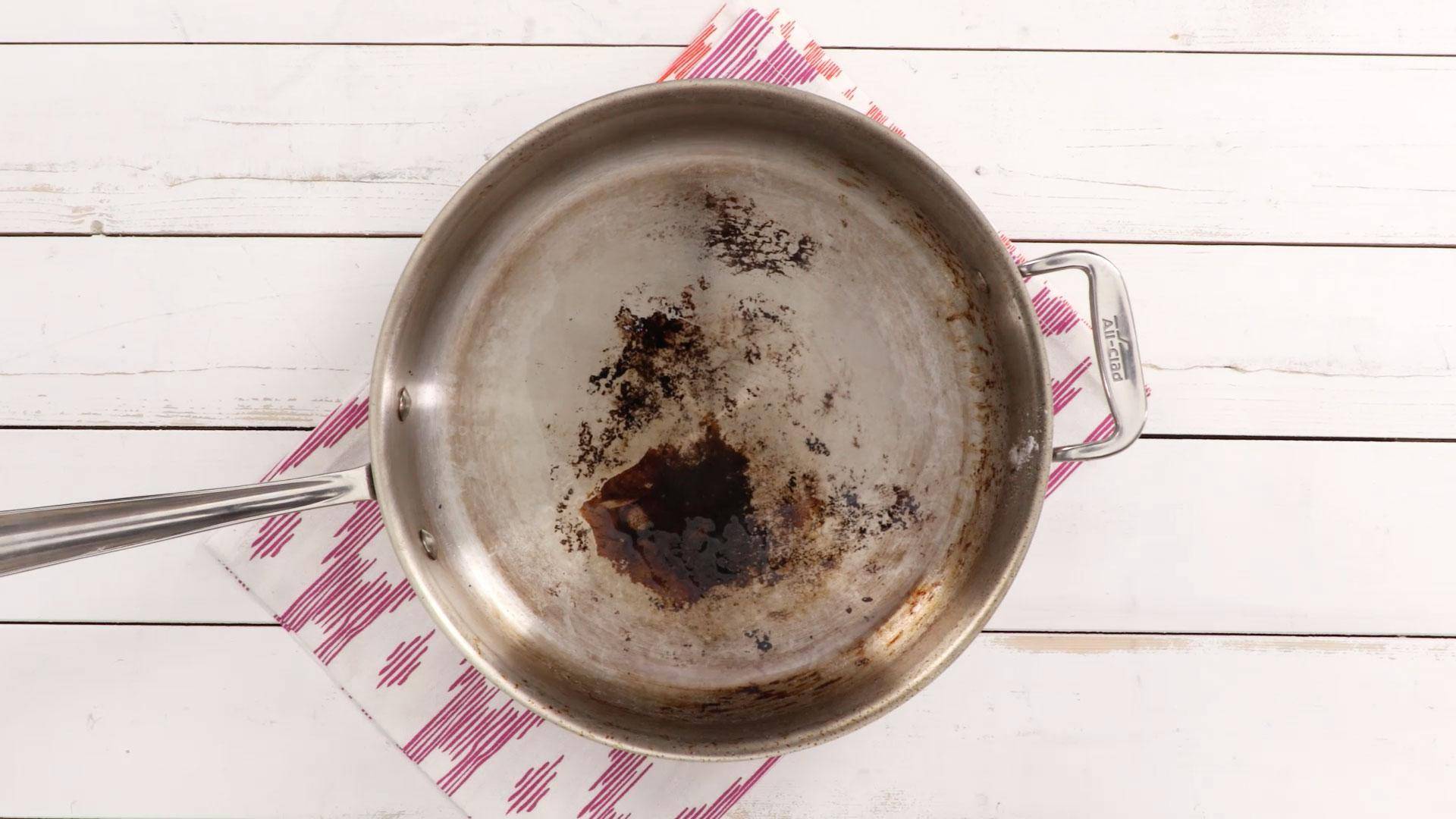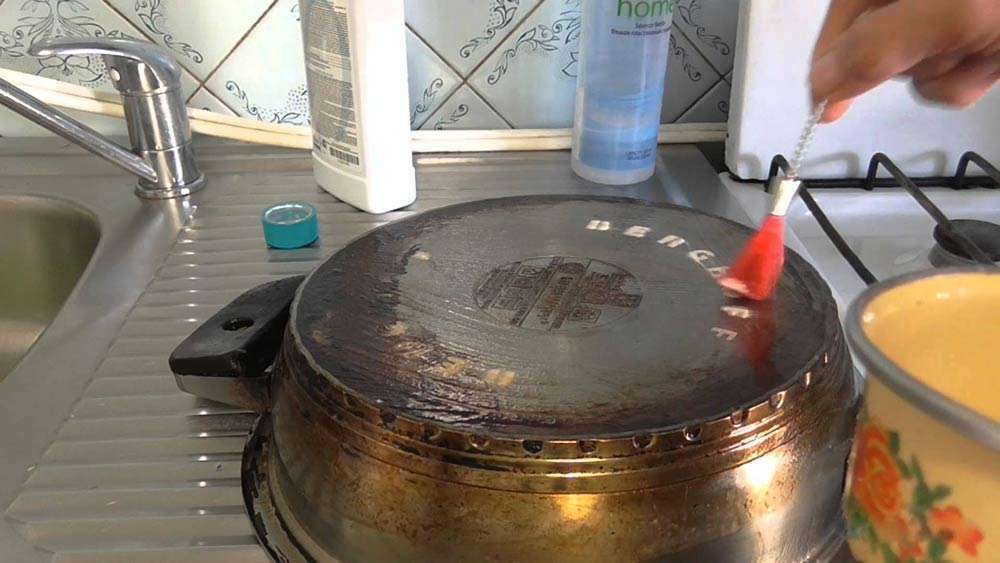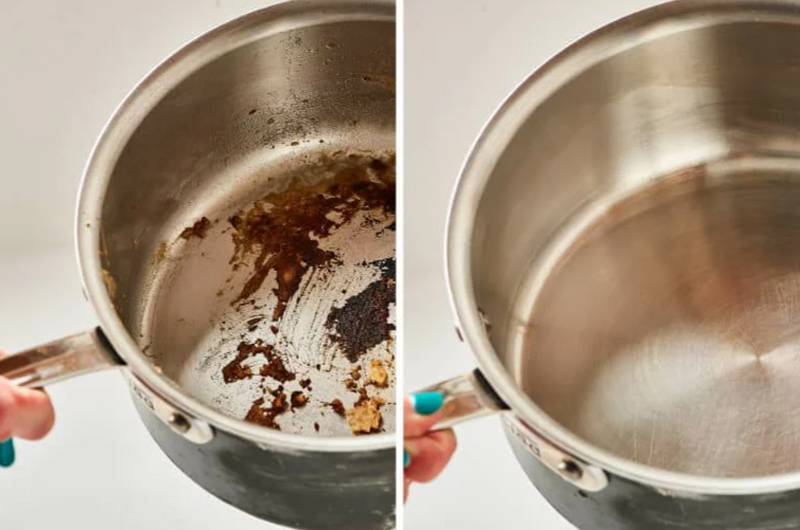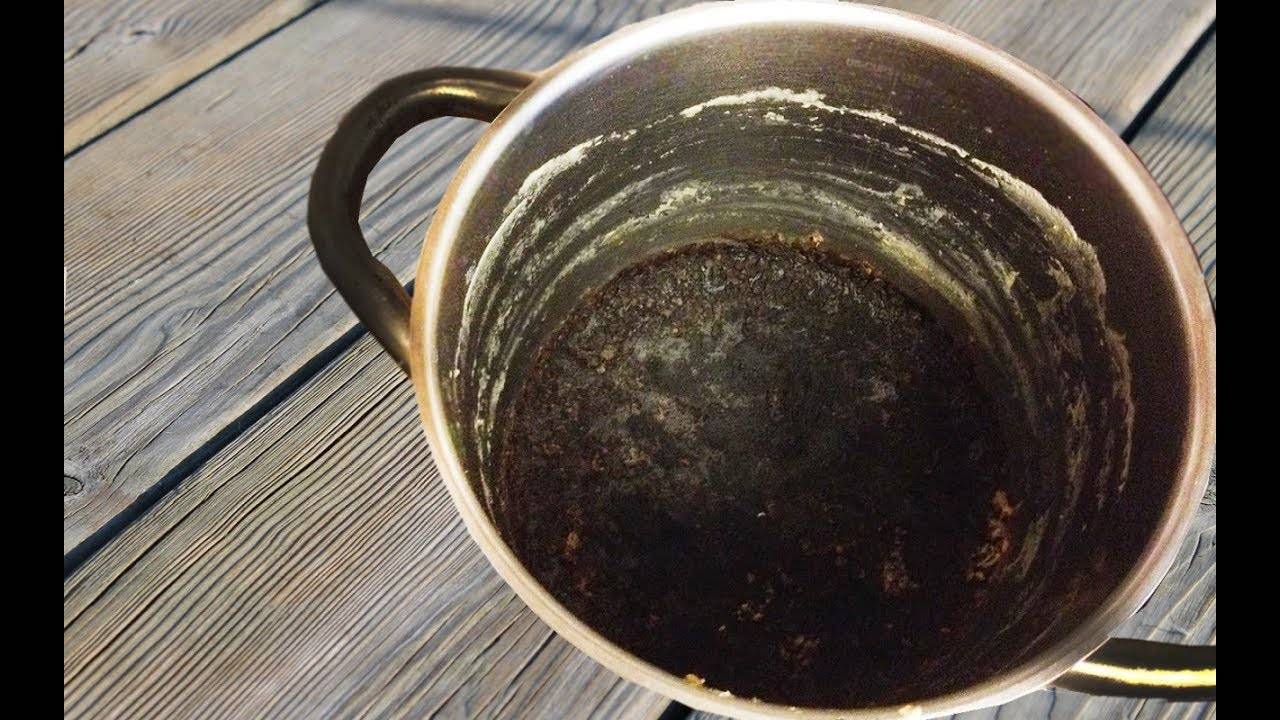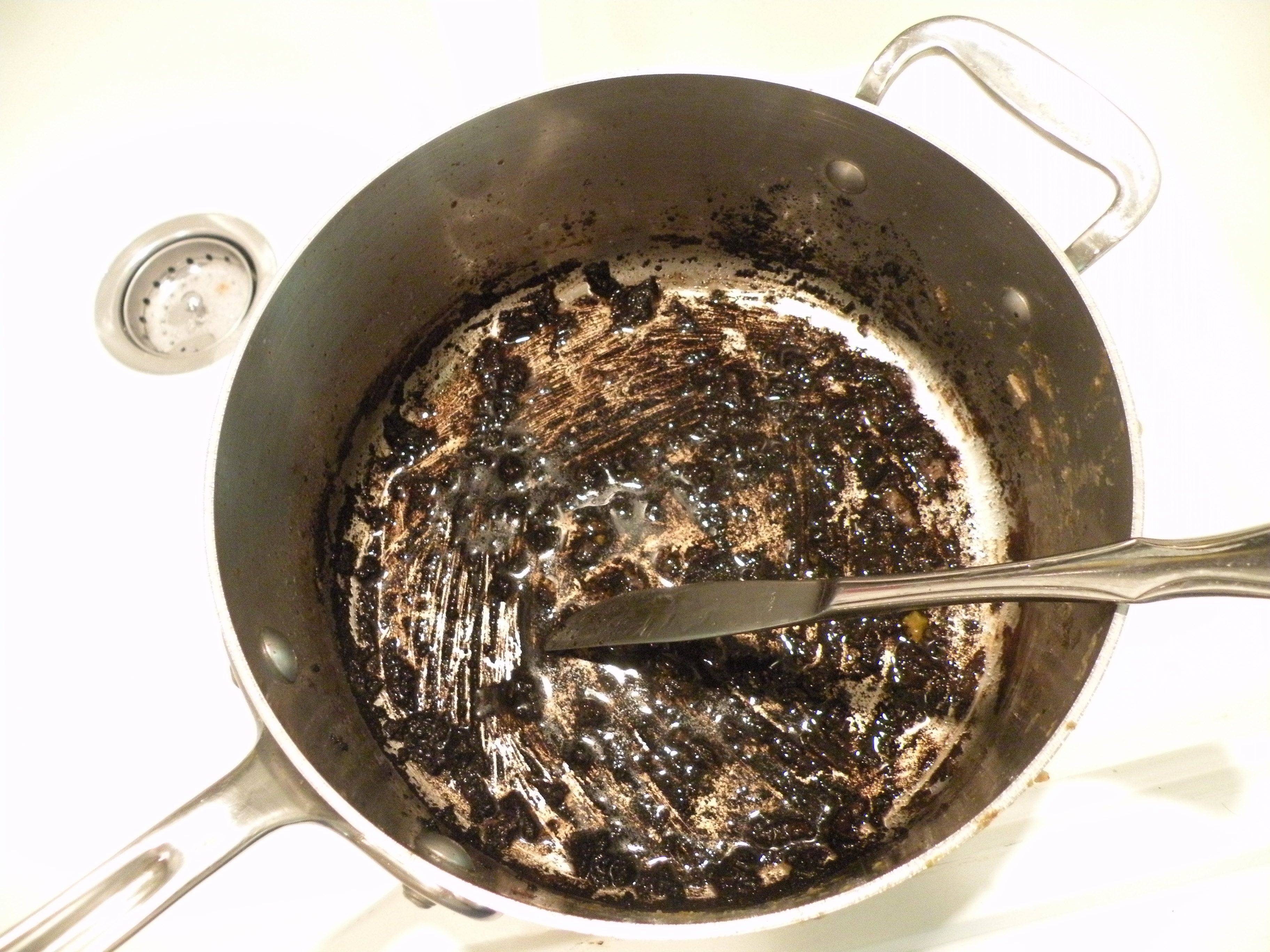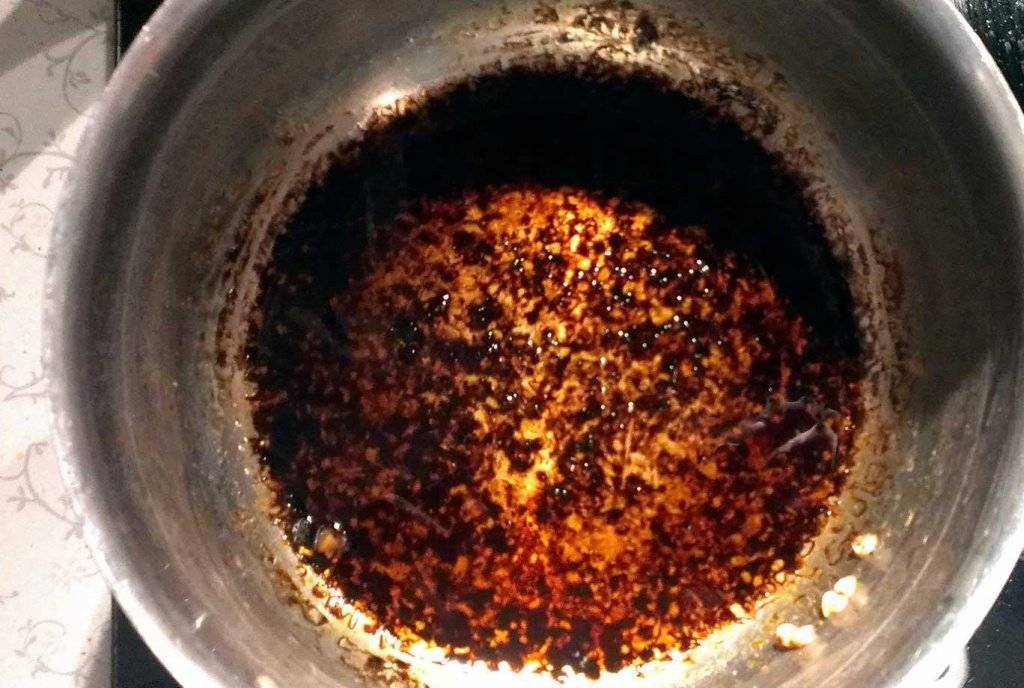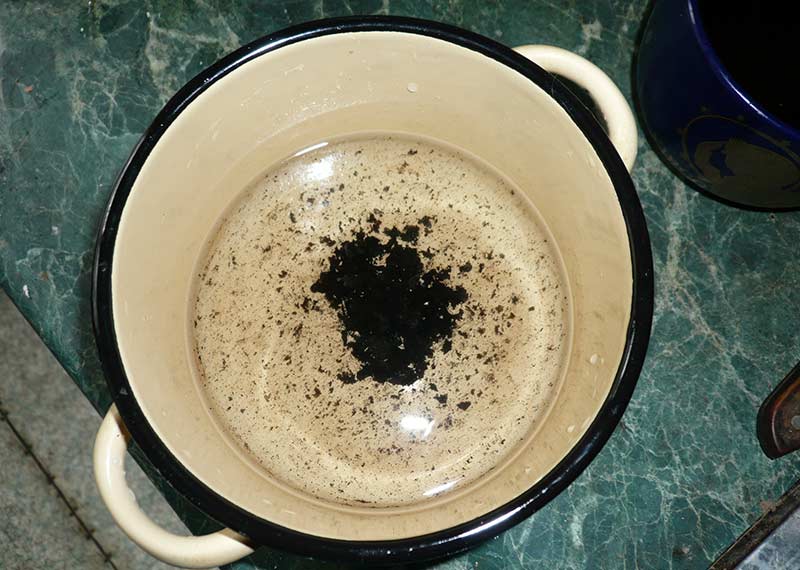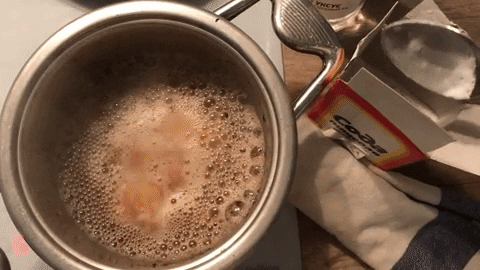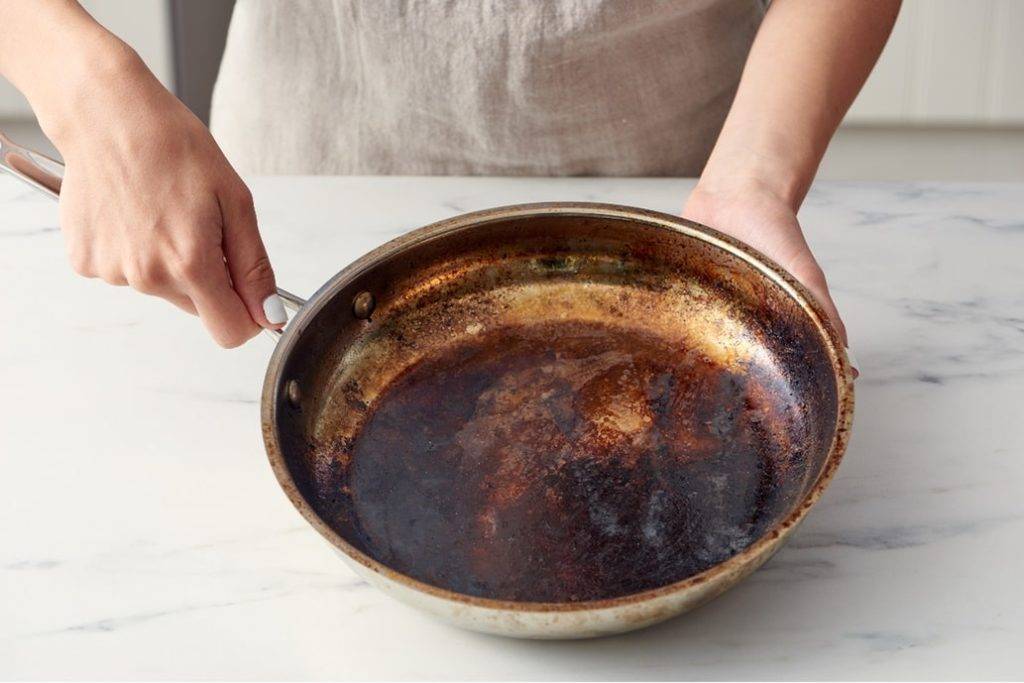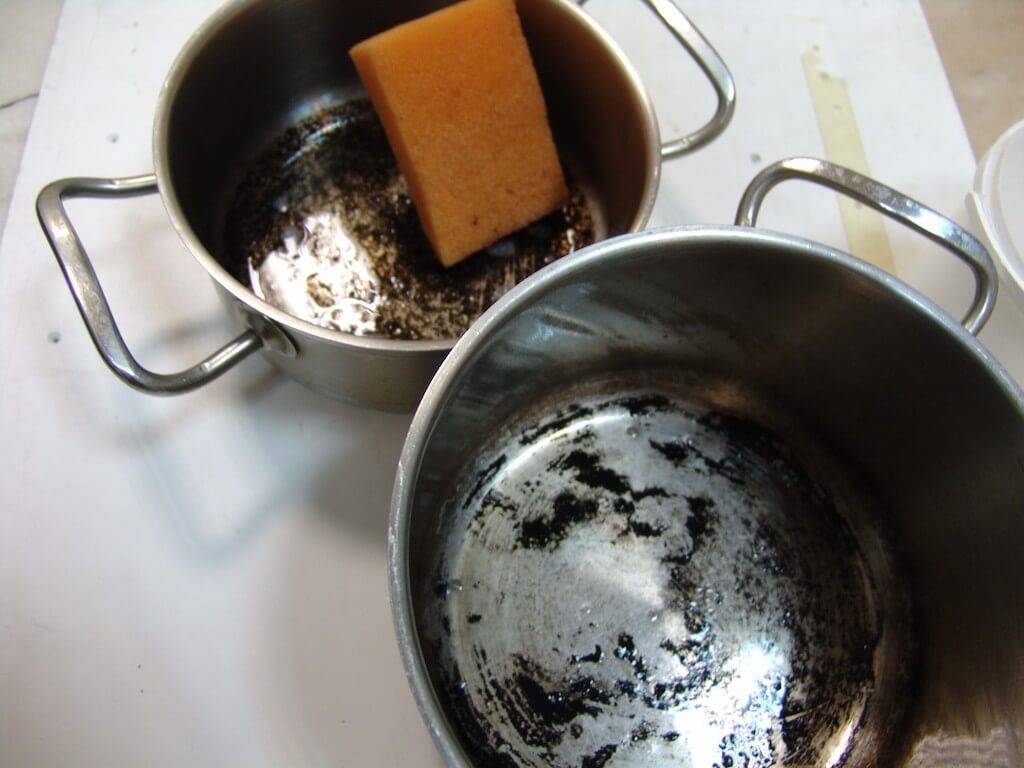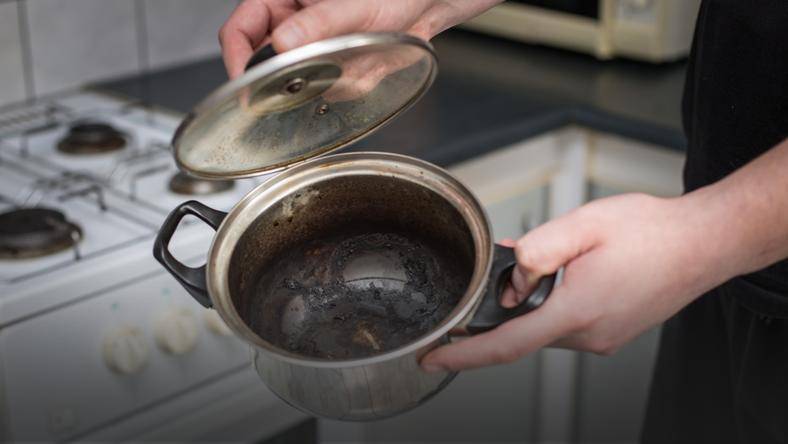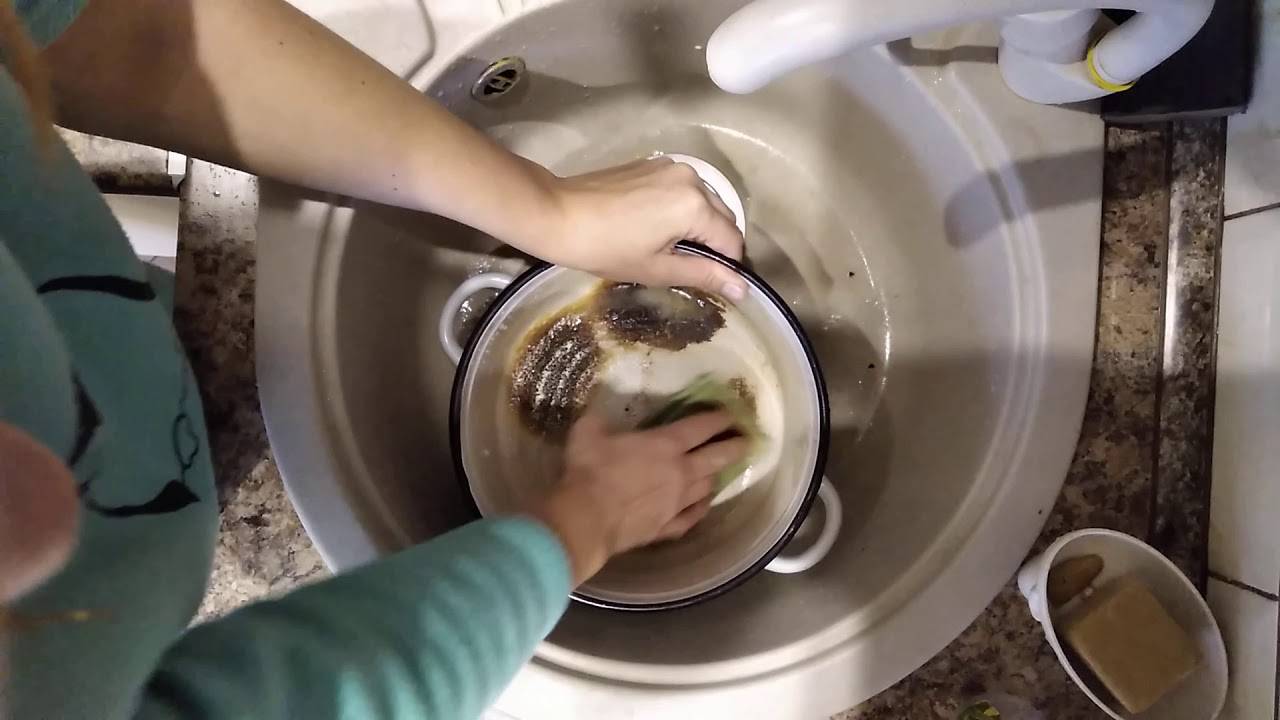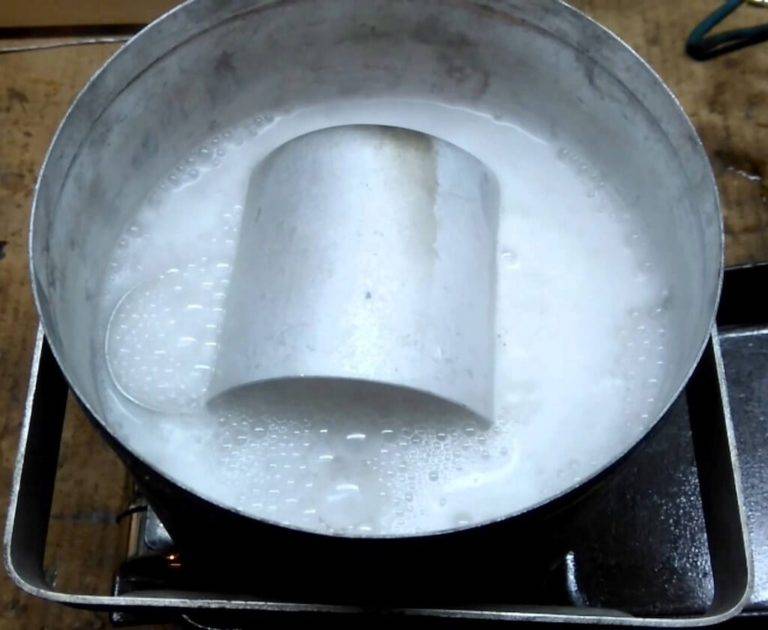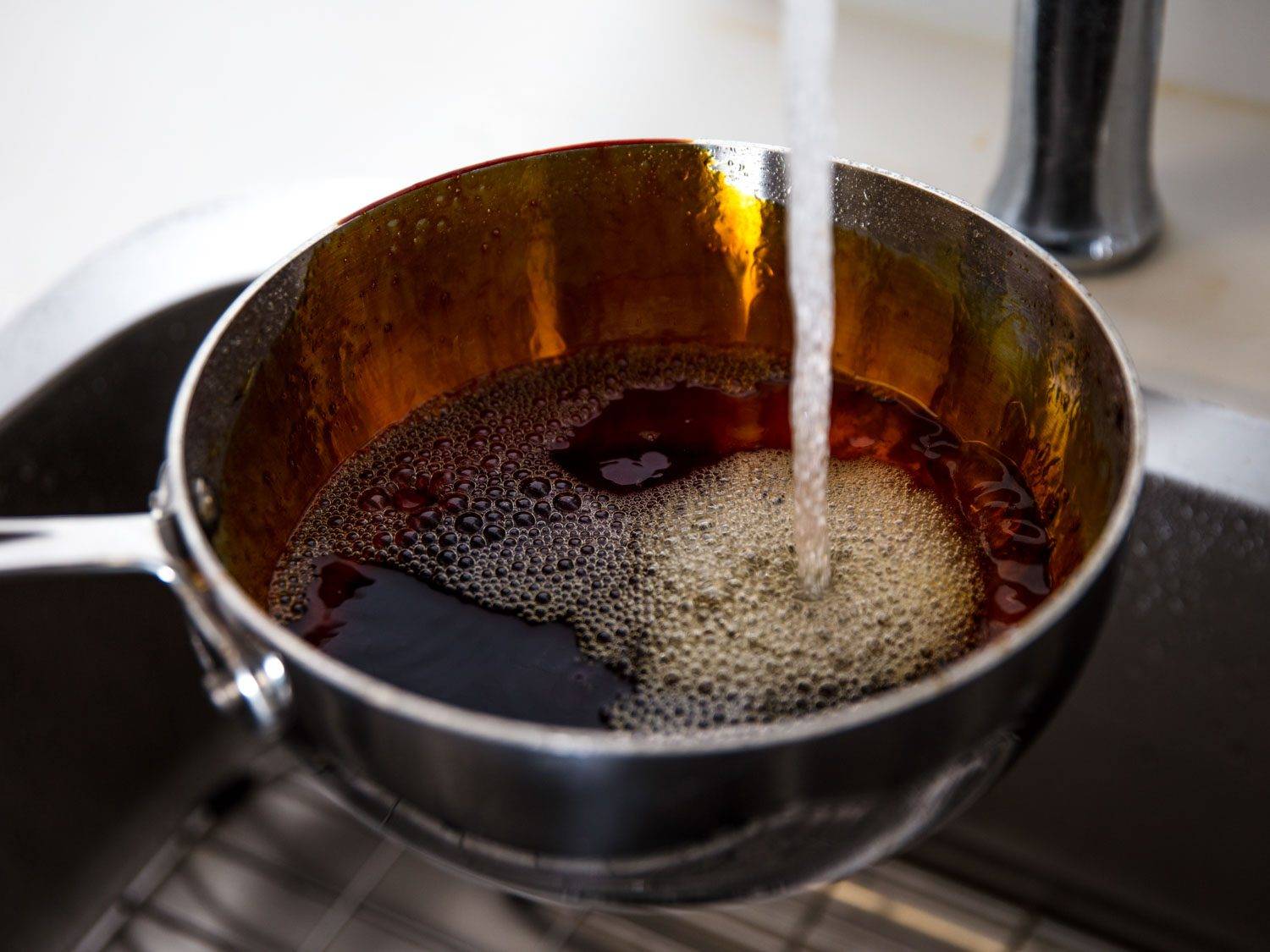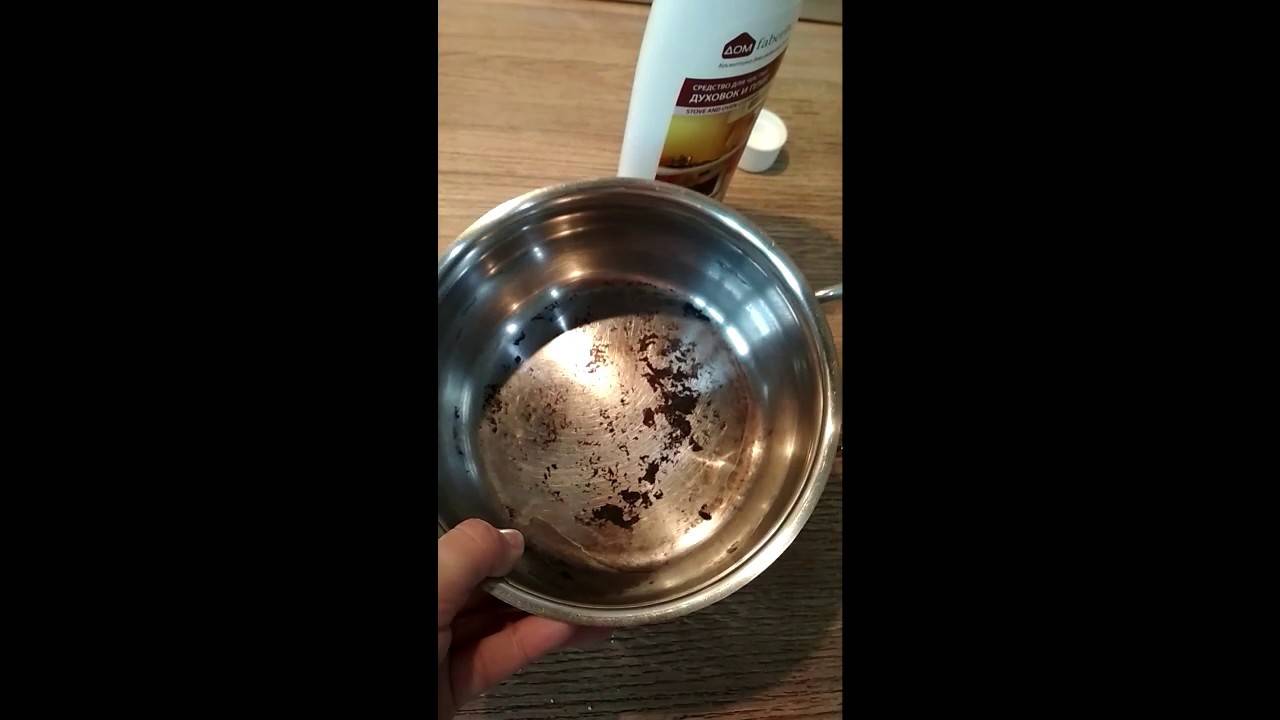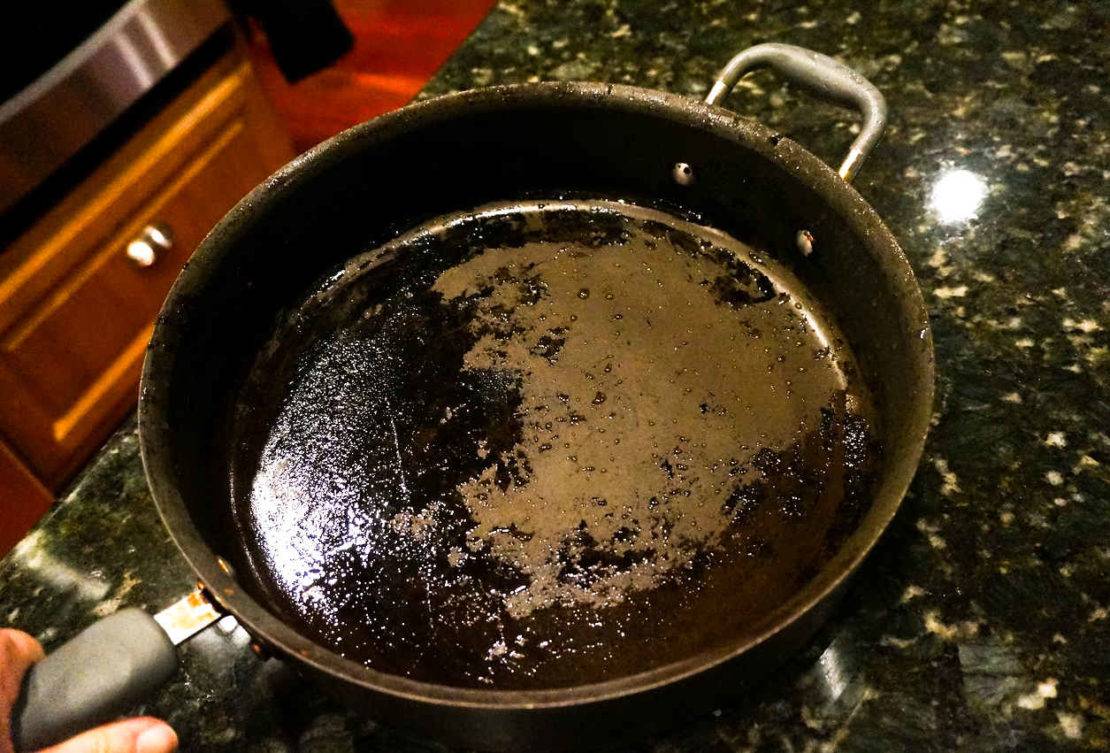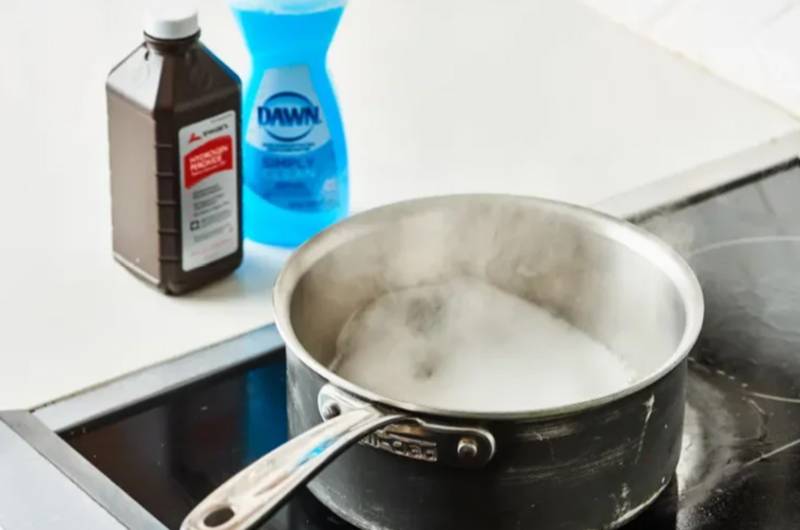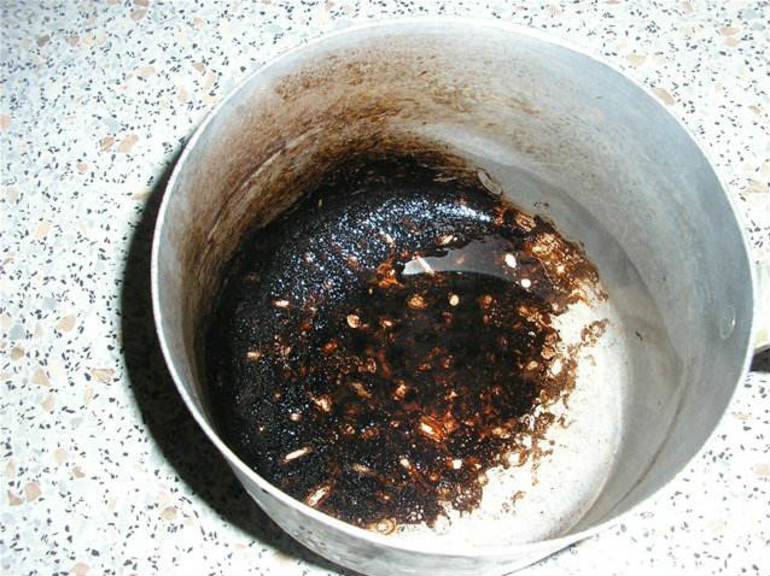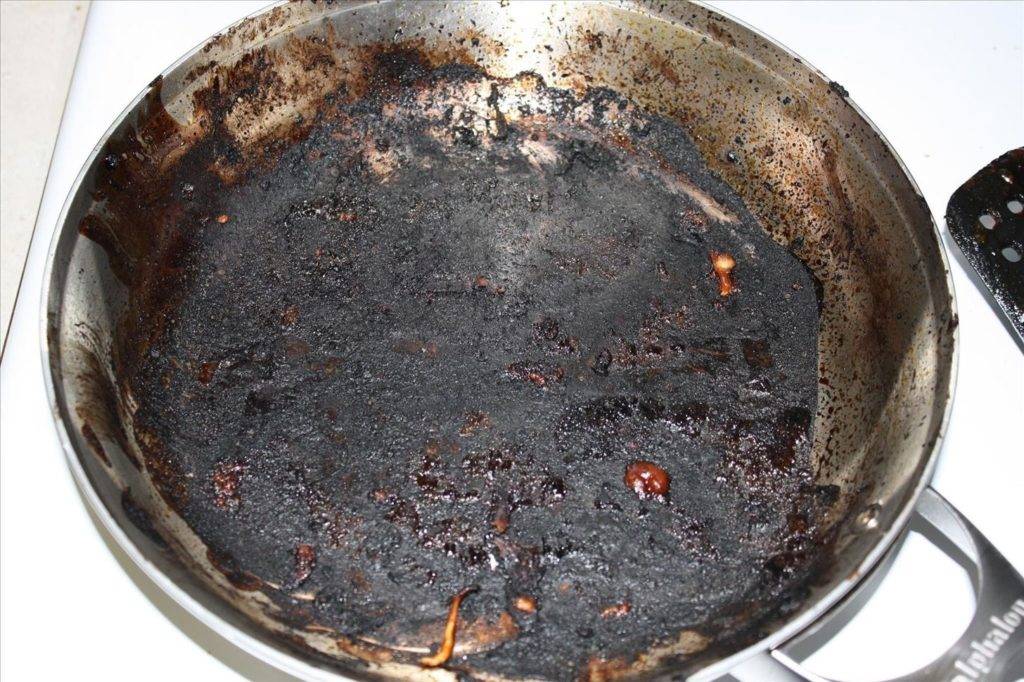How to clean a pot with household chemicals
To remove old dirt and grease from the walls of the pan, not only traditional methods will help, but also modern detergents.

After use, wash the pan with sufficient running water and a mild detergent.
Abrasive powders are dangerous in that they can scratch metal surfaces, but they can be used as a solution by mixing with boiling water. In this case, they are quite effective.

Proper washing will prevent ugly dark spots and streaks from appearing on the walls and bottom of the dishes.
Creamy products show good results, especially if you soak dirt with them. But with strong soot, they are not always effective.
How to remove dirt outside and inside: homemade recipes
You can use home remedies to remove blackness or soot from an aluminum pan and remove carbon deposits. They are almost always at hand for any housewife:
- salt;
- Activated carbon;
- vinegar;
- milk serum;
- lemon acid;
- apples;
- soap;
- ammonia.
How to clean a mild burn
If plaque has recently appeared on the bottom and walls, do not use aggressive cleaning agents. Try to return the pan to its original appearance with the help of available tools.
To immediately remove fresh carbon deposits, fill the pan with whey, leave for 24 hours and rinse with a soft sponge. Burnt food or milk residues will disappear.
Serum helps remove carbon deposits from the bottom of the pan
Sour apples help remove minor dirt inside and outside the pan. Cut them into pieces and rub the problem areas hard, the blackness will disappear.

Sour apples help remove light carbon deposits
Another remedy is laundry soap. Grate it, add to water and boil for 20 minutes.
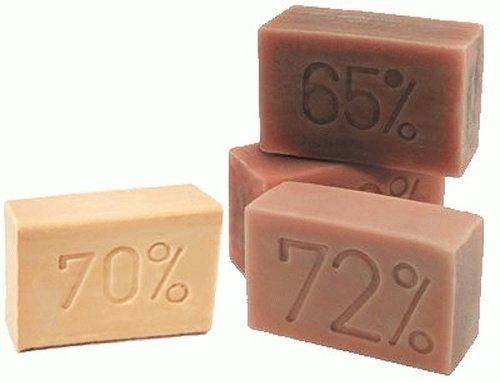
Laundry soap will wash the burnt bottom of the aluminum pan
After cooling down, rinse the inside of the pot with a sponge.
All of these products are only suitable for removing light burns. To remove stubborn dirt, use salt, vinegar, or ammonia.
We remove strong plaque from burnt food and darkening on the inner walls
You can remove the remnants of burnt food from the bottom of the aluminum pan with ordinary salt.
- Fill the pot with cold water, leave for 10 minutes.
- Drain the water, cover the burnt bottom with salt.
- Leave it on for 2-3 hours.
- Remove carbon deposits with a soft kitchen sponge and commercially available detergent.
Salt helps remove carbon deposits from burnt food and restores the look of dishes.
A solution of salt and water copes with darkening on the inner walls:
- Mix water and salt in a 1: 1 ratio.
- Apply the mixture to a cleaning sponge.
- Wipe dark areas in the pan.
How to wash off burnt milk residues
Activated charcoal helps to remove burnt milk from the bottom of the dishes.

Activated charcoal helps to cope with carbon deposits from burnt milk
If you have such a nuisance, use a simple recipe:
- Crush 3-4 tablets of activated carbon.
- Cover the bottom of the pot and leave for half an hour.
- Without removing the powder, fill the pan with cold water for another 30 minutes.
- Wash off dirt with a sponge and detergent.
We remove fat and dark carbon deposits with table vinegar
Stubborn traces of fat and soot inside the pan are removed with 9% table vinegar.
- Pour vinegar and water into a saucepan (a glass of vinegar per liter of water).
- Bring to a boil.
- Cool and wash with soap and sponge.
When boiling this solution, ventilate the room. Vinegar fumes are hazardous to health.
How can you remove limescale from the bottom and walls
With daily use, lime deposits form on the bottom and sides of aluminum pans. You can remove it with citric acid.
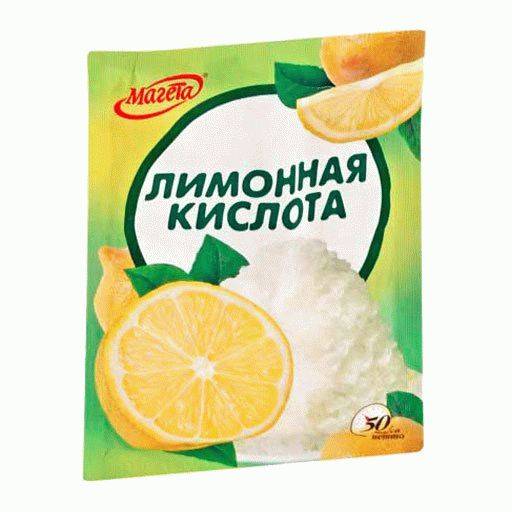
Citric acid will deal with burnt food and remove limescale
- Fill a saucepan with a burnt bottom with water.
- Bring it to a boil.
- Add 2 tbsp. l. citric acid.
- Boil for another 15 minutes.
- Cool to room temperature.
- Wash with soap and sponge.
Recipe for removing heavy burns or soot
To remove long-standing carbon deposits or grime, you will need laundry soap and ammonia.
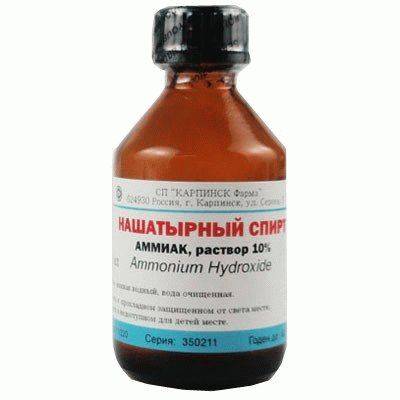
Ammonia in combination with laundry soap removes old traces of grease and soot, restores its former shine to the pan
The recipe for the cleansing mixture:
- Grate half the bar of laundry soap.
- Dissolve it in water.
- Add 1 tbsp. l. ammonia.
- Bring to a boil.
- Boil for 15 minutes.
- Cool and rinse the pan.
Provide fresh air in your kitchen when using this recipe. In the process of boiling the mixture, caustic ammonia vapors are released, which can be hazardous to health.
Causes of food burning
Food often burns due to carelessness. The hostess is distracted and forgets that there is a saucepan on the burning stove, the liquid evaporates, and the dishes settle in a dense burnt crust at the bottom of the container.
Even the modern Teflon coating will stick to food. This is primarily due to the long service life, since over time, scratches and microcracks appear on the surface, which become the main cause of food burning.
Damage forms over time on both aluminum and cast iron pans. In this case, inconvenience is caused not only by the process of cooking, but also by the subsequent washing of dishes - it is very difficult to wash it.
How to remove dirt at home
In order to figure out how, it is absolutely not necessary to use expensive store tools. To wipe off the fumes, homemade methods of removing contaminants are also quite suitable. The best helpers in this matter may well be salt, vinegar, ammonia, etc.
Salt
With the help of salt, you can effectively remove most types of dirt and figure out how to clean the pot of burning. Using this method involves dissolving salt in warm or hot water, as in cold water, a chemical reaction occurs that causes oxidation and darkening of the dishes.
To clean the dishes, you need to take water into the bowl and add 3 tablespoons of salt there. After 3 hours, wash the pan under running water and wipe the most contaminated areas with a sponge. You don't even have to make special efforts to do this.
 Using vinegar, the dishes can be cleaned to a shine.
Using vinegar, the dishes can be cleaned to a shine.
Vinegar
This tool does an excellent job with burning and allows you to clean dishes to a shine. You can clean the stainless steel with nine percent vinegar, just pouring the bowl so that it will sour for several hours. After that, it remains only to rinse the vessel in warm water to remove the remaining vinegar.
The second method involves using a mixture of several cleaning agents at once: vinegar, soap and water. To begin with, fill the pan with warm water, then add 100 ml of vinegar and a bar of laundry soap grated on a coarse grater. The mixture should be boiled over low heat for about an hour.
When using the method of cleaning stainless steel dishes by boiling a solution of laundry soap and vinegar in it, a large amount of toxic fumes is released into the air. This method should only be used in a well-ventilated area.
 Citric acid will help get rid of carbon deposits and limescale.
Citric acid will help get rid of carbon deposits and limescale.
Lemon acid
If carbon and scale appear on the dish, you can use the optimal cleaning method - citric acid, which is available in the kitchen of every housewife.The cleaning method is simple: you need to put water in a saucepan and boil it. 2 tablespoons of the product are poured into the boiling liquid. The solution should boil over medium heat for at least 15 minutes. When the pan cools down, all that remains is to wipe the walls with a sponge so that the pot shines clean.
Hydrogen peroxide
You can use a solution of ammonia and soap to clean the burn-on from the outside and from the inside. To do this, you need to grate half a bar of laundry soap on a grater, add a tablespoon of ammonia to it and pour this mixture with water. The contents of the cookware should boil over medium heat for 30 to 40 minutes. After that, the dirt can be easily removed with a regular cloth.
 The hydrogen peroxide will help cleanse the outside and inside of the pot.
The hydrogen peroxide will help cleanse the outside and inside of the pot.
Soap
In the process of scraping off fat and burning from dishes, soap helps a lot.
At the same time, it is absolutely not important in what form to use it: liquid and laundry soap in bars copes equally well with carbon deposits. Only the proportions of its application change
In the case of liquid soap, 100 ml of soap will be enough for a pot of boiling water, and in a situation with a household one, you will need about a third of a bar grated on a regular kitchen grater. The mixture must be boiled over a fire for about 30 minutes, after which the water is drained and all remaining dirt can be easily removed with a regular sponge.
Do not put a steamed pan under cold water: a sharp temperature drop will only exacerbate the problem and lead to quick wear of the pan. You can enhance the result of using soapy water by adding a tablespoon of PVA glue to the boiling mixture.
 One of the best ways to clean dishes is to use soap.
One of the best ways to clean dishes is to use soap.
Types of pollution
In the course of long-term operation, even on such an alloy resistant to external influences, contamination can appear. The most common defects that occur are:
- Limescale. If ordinary tap water is often boiled in a saucepan, then some impurities can settle on the walls of the container. The shade and chemical composition of such scale depends on the region and the technology of water purification. Usually, ring-shaped patterns of light brown or reddish color appear at the bottom.
- Rainbow spots. Stainless steel dishes have a thin layer of inert oxide film. When the dishes are heated above 100 ° C, such a film begins to thicken. When the layer is enlarged 10 times, it will take on a bluish or iridescent color. This coating does not in any way affect the performance of the cookware. To avoid such an unaesthetic defect, do not heat an empty container on the stove.
- Yellow coating. The appearance of a yellow sticky plaque is dictated by the accumulation of oil sludge. During cooking, the smallest drops of fat are deposited on the outer and inner surfaces. Over time, an unpleasant sticky layer appears.
- Black carbon deposits. Such a layer (most often covering the outside of the dish) is dictated by the long accumulation of oil droplets. Black carbon deposits form after many years of improper use of cookware. It is a rigid framework that is very difficult to deal with. Black carbon build-up inside the pot is usually caused by food being burnt.
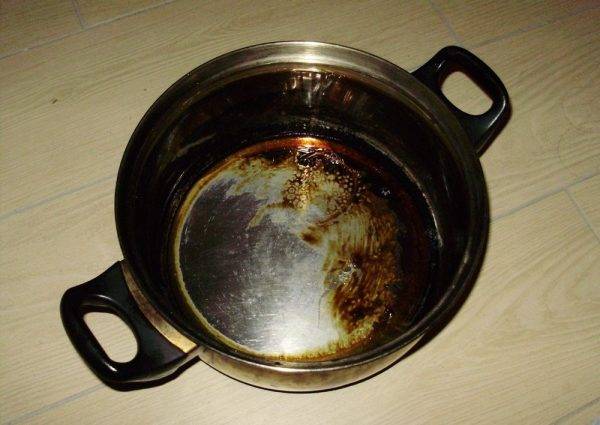
After burning food, a black coating may appear on the bottom of the pan.
How to care for a stainless steel pot
During use on stainless steel pans, a layer of grease begins to form over time, which can accelerate surface wear. Utensil care implies daily high-quality cleaning.
- After completing the cooking process, the dishes must be rinsed with sufficient water and detergent. This will help prevent the possibility of dark spots and get rid of dried-on food particles. It should be remembered that according to the recommendations of the manufacturers of stainless steel dishes, the washing process must be started some time after use.This will protect the coating from destruction due to a sharp temperature drop.
- It is not recommended to clean stainless steel pans with abrasive materials or metal scrapers, which can scratch the surface.
- The use of dishwashers is not recommended. It is advisable to wash the dishes in warm water using soft sponges. However, if the information in the instructions for use of the product confirms the possibility of using the dishwasher, it is advisable to pre-soak the dishes in soapy water. This will allow you to more efficiently and safely deal with various types of pollution using modern technology.
- After washing, it is advisable to wipe the pan dry, as water droplets on its surface can cause stains.
- It is best to wipe the dishes with dotted movements, which give the surface not only perfect cleanliness, but also smoothness.
-
You can use raw potatoes to add shine to stainless steel. Cut it in half and use these halves to rub the entire surface of the pot.
Cleaning pots using the listed methods will ensure the dishes look great, as well as take care of the possibility of their long-term use. In addition, hand-made cleaning products can be the key to reasonable savings and guarantee an excellent effect comparable to purchased counterparts.
Traditional methods
All recipes are very simple. They are based on the properties of natural substances found in every kitchen.
Boiling
The recipe was invented by the hostesses during the Soviet era. At that time, there were practically no household chemicals in stores. Everyone used the means at hand.
Inside
The cleaning solution is poured into a stainless steel container. Put it on a burner, heat the liquid to a boil, simmer for at least 2 hours. Leave to cool. The solution is discarded. Rinse the pan, wipe dry.
Outside
Take a large enamel bowl or tank. Fill it with a cleaning solution. They put it on the stove. They lower stainless steel objects into it. The liquid should completely cover them. The dishes are boiled for at least 2 hours. Remove from the pan when the solution has cooled. All items are washed under running water and wiped.
How to prepare the composition
Take the required amount of water. The working solution is prepared based on the following proportions:
- water - 5 l;
- stationery glue - 100 ml;
- soda - 500 g.
Carbon Pastes
In the kitchen, there is always a tool that can be used to scrub burnt milk, porridge.
Crushed activated carbon
The remains of burnt porridge are quickly removed with activated charcoal. The tablets are crushed. The powder is poured into the bottom of the pan. Pour water into it. After 15 minutes, the carbon is easily rubbed off.
Ground coffee beans
The zealous housewives do not throw away the filters with the dormant coffee. They use thickened instead of a body scrub and metal pot cleaner. It is applied to the contaminated area, rubbed with a sponge, left for 10 minutes, washed off with water.
Liquids from white deposits and limescale
Limescale builds up in the kettle and white deposits on the sides of the pot. The cause of the deposits is hard water. There are 3 remedies that can easily deal with this type of contamination.
Citric acid solution
Fill the kettle with ⅔ water. Pour in 20 g of citric acid. Boil. Allow the water to cool and boil one more time. Plaque removal is started after a few hours. Wipe off with a sponge or brush.
Coca Cola
Fill ⅔ of the saucepan with the drink. Bring it to a boil. Leave to cool. The plaque is wiped off after 30 minutes. Use a brush or sponge.
How to handle cutlery
Spoons, forks and knives lose their luster over time and contact with food. Bring back the radiance with the means available.
9% vinegar and lemon juice are equally effective. They are applied to the cutlery with a flannel napkin.After 30 minutes, rinse, wipe dry.
Ammonia
The lost shine is restored with ammonia. It is added to water - 1 tsp / l. The stainless steel cutlery that was washed before is lowered into the basin. After 5-10 minutes, rinse spoons, forks, knives, wipe dry with a kitchen towel.
Non-abrasive toothpaste or powder
Means remove the yellow film, polish the surface. A small amount of paste is applied to the surface, rubbed with a napkin. After rinsing, wipe off and rub until shiny with a towel.
Mustard powder
Mustard powder has cleaning properties. It is used to make a paste. Stir constantly, pour in warm water. The mass is applied with a brush to the tarnished stainless steel surface.
Work with table vinegar with gloves. It quickly removes all types of dirt. It is applied to a soft sponge and wiped on tarnished metal surfaces. Strong films of old fat do not lag well. To enhance the cleaning effect, lemon juice is added to the vinegar. After the procedure, the dishes are rinsed.
Lemon juice solution
Squeeze the juice from half a lemon. For 1 liter of water you need only 1 tbsp. l. The resulting solution is moistened with a sponge and wipe the pan with it from the inside and outside. Rinse it with water and wipe it dry with a towel.
Steel polish
You don't need to run to the store. There is an effective polish in the kitchen.
Raw potatoes
To make the kettle shine like new, wash the potato, cut it into 2 halves. Rub them on a steel surface. Shine on pans in the same way.
How to get rid of burnt jam
Burnt sugar is difficult to peel off. The work is simplified by using table vinegar and laundry soap for cleaning. Water is poured into a saucepan. Pour in soap shavings. Bring to a boil. Remove the pan from the burner. Pour in ½ tbsp. vinegar. When the water cools down, wipe off the pollution.
How to remove rust
Remove small rusted areas with baking soda. The surface is moistened with a sponge. Powder is applied to her. After 60 minutes, try to scrub the rust off with a brush. If the result is achieved, the surface is washed with clean water and wiped.
With regular care, stainless steel dishes do not tarnish. It serves for many years, while maintaining an attractive appearance and functionality.
p> Share link:
Cleaning methods
The more the pan is used with carbon deposits, the less chance of cleaning it in the future. However, this is not the only reason to clean all the dishes at home, carbon deposits have a negative effect on human health. When cooking in dirty dishes, burnt fat particles get into the dish, causing heartburn and diarrhea. In order to get rid of blackness, you need to know and use both modern methods and folk.
Fundamental rules
Enamel is a fragile coating that can be damaged with a simple iron float. Even the use of familiar chemicals can lead to complete damage to your favorite dishes. Every owner should know how to clean a burnt enamel pan and not harm it.
 It is not recommended to use an iron grater for enameled dishes.
It is not recommended to use an iron grater for enameled dishes.
Therefore, the basic rules should be highlighted:
- Do not use abrasive products. These include: cleaning powder, coarse brushes, iron tools;
- For high-quality and quick cleaning, it is necessary to steam the pan while the carbon is fresh;
- Use only mild detergents during work.
These rules relate more to how to preserve the enamel from the inside. Even minor damage will cause food to stick to the surface during cooking. There are no rules for the outside, you can use any means if the question is not about preserving the design. If it is still important, then the set of rules will be the same.
 Dry mustard and baking soda will help clean up a burnt pot.
Dry mustard and baking soda will help clean up a burnt pot.
Remove fat
Modern remedies are not always ready to help, especially if there is a generous layer of fat on the dishes. Turning off hot water exacerbates the problem. It is recommended to use folk remedies only if there are no means for enameled dishes at hand. As a worthy example, experienced housewives allocate cheap funds from a domestic manufacturer:
- Chister;
- Antifat;
- Acrylan.
However, when they are not at hand, the question arises: "How at home and folk remedies?" Alternatively, use baking soda and dry mustard. However, there is one condition, it is necessary to fill the mixture with warm water. The method is effective if you dilute 0.5 cups of soda or mustard with boiled water and apply the paste to the entire surface of the oily dishes. It is forbidden to use the coarse part of the sponge.
 One of the popular folk remedies for cleaning dishes is citric acid.
One of the popular folk remedies for cleaning dishes is citric acid.
Remove carbon deposits
Quick removal of carbon deposits is possible if it is steamed or soaked. If this was not done at the beginning, you will have to make a lot of effort to remove the musty layer of burn-in. However, for this you can use the standard folk method - boiling with citric acid. The method is suitable for removing fresh and old plaque.
To do this, you only need 1 packet of acid and boil for 30 minutes over low heat. After such a bath, carbon deposits independently move away from the dishes without damaging its surface.
 The vinegar will help get rid of the unpleasant smell of the pots.
The vinegar will help get rid of the unpleasant smell of the pots.
Remove burnt odor
You can ideally wash the pan after an unsuccessful preparation of a fish dish, but the smell will haunt for a long time. In order to get rid of the persistent aroma that is transmitted to new dishes, it is necessary to rinse the dishes with vinegar or beer. Beer well interrupts the smell of fish and meat products after soot, vinegar can kill bacteria.
Both methods are effective, it is up to the hostess to decide which one to use. Alternatively, commercial detergents can be used to remove unpleasant odors. Standard soaking time is 15-20 hours.
Fresh beets will help get rid of the dark color after peeling. It is necessary to rub the entire pan with the cut part and leave for 10 minutes until dry. After that, you can rinse off the residues with cold water.
How to clean stainless steel products inside and out
Very often the pan becomes covered with ugly carbon deposits, not only on the inner walls, but also on the outside. If the burnt layer is not very thick, it can be removed using simple folk methods such as baking soda, activated carbon, or coffee.
Baking soda
Regular baking soda is an excellent cleaner. To clean dirt, for example, burnt buckwheat or rice, you need to dissolve soda in water (half a kilogram of powder per 5 liters of water) and pour the mixture into dirty dishes. After that, the pot is placed on a small fire and boiled for about 2 hours. To clean the outside of the pot, which also burns constantly, it must be boiled in a similar manner in a large metal bowl or bucket. In this case, the amount of water and soda during cooking approximately doubles.
 Milk whey is one of the most effective dish cleaning agents.
Milk whey is one of the most effective dish cleaning agents.
Milk serum
This method is not as popular as the previous ones, but it is no less effective. It was used back in Soviet times to clean pots and pans with varying degrees of soiling. So that the carbon can be easily wiped off with a regular washcloth, you need to pour milk whey on the bottom of the dish so that the dirt is hidden under a layer of liquid for several centimeters. You need to leave the pan to sour in the whey for about a day, after which all contaminated areas that have had time to burn can be simply wiped off with a sponge and rinsed under running warm water. After that, the pan will not only become cleaner, but also shine with renewed vigor.
 You can get rid of the accumulated carbon deposits by using activated carbon.
You can get rid of the accumulated carbon deposits by using activated carbon.
Activated carbon
If food residues are suddenly burnt to the bottom, then you can get rid of the accumulated carbon deposits by using activated carbon. You can buy it at a low price in any pharmacy in the city. In addition, activated carbon is also one of the most harmless agents that do not adversely affect the surface of the skin, even in direct contact with it.
One plate of tablets is enough for the cleaning procedure. You can crush them in a small mortar or use a spoon. After that, you need to fill the burnt bottom of the dishes with the resulting powder and pour 100 ml of water or soap solution into it. After half an hour, the pot can be washed using regular dish detergent and a soft sponge. It is better to wash the pan in warm running water. If the carbon deposit was strong, you can increase the duration of the oxidation to an hour or two.
 The coffee grounds can also help get rid of carbon deposits.
The coffee grounds can also help get rid of carbon deposits.
Coffee grounds
You can also use coffee grounds to clean stainless dishes. It acts on the material in much the same way as activated carbon. The tool is quite budgetary, because for one cleaning of the pan, it is enough for several days to collect the remaining grounds after drinking coffee in a separate container.
Apply a small amount of coffee grounds to a sponge and rub the sides of the pot. After that, you need to rinse the vessel with warm water. This will help return the metal not only to its purity, but also to its shine.
 With a large number of divorces, ammonia will help to cope.
With a large number of divorces, ammonia will help to cope.
Ammonia
If a large number of streaks and dark spots appear on the dishes, it will be easy to get rid of them with ammonia. In order to increase the effectiveness of this method, you need to dilute the toothpaste (without bleaching ingredients) with a small amount of ammonia to the state of a liquid gruel.
It is necessary to blot a small microfiber cloth or other soft cloth and rub the surface of the pan with the mixture. After 15 minutes it is necessary to rinse the vessel under the pressure of cold water.
Cleaning dishes with apple peels is one of the oldest methods.
Folk recipe using apple peel
The way to clean a burnt stainless steel pan inside with a peel is one of the oldest. It is necessary to peel 1 kg of green apples and pour boiling water over the skin. The rind should be simmered for 15 minutes. During this time, the carbon deposits inside the pan will get wet and can be easily removed with a regular washcloth.
Cleaning heavily burnt pots with household chemicals
Household chemicals on a burnt pan have the same effective effect as folk tricks
But when choosing, you need to pay attention to the mark for what type of material this or that substance is intended.

Top best products for removing burnt and carbon deposits
1 "Shumanit" - a train from Israel. Has the form of a spray, powder, gel. Used on glass ceramics, metal, ceramics, tiles. For cleaning, a little composition is applied to the contaminated place, wait a few minutes, rinse abundantly with a sponge. If not everything left the first time, the actions are repeated. Shumanite has a pungent odor and a high content of decomposing substances, therefore, it can only be cleaned with gloves, in a ventilated room away from food.

2 Cillit Bang has many different formulations for cleaning stoves and other surfaces from burning, but it can be applied to pot stains as well. The positive is the absence of a pungent odor and corrosive effect on the skin, but it is still worth using gloves. After cleaning, the kitchen utensils are rinsed.
3 Mister Chister is a liquid suitable for various materials. Its cleaning properties are weaker, but the smell is nicer. He is able to cope with old dirt. Wear rubber gloves for protection.
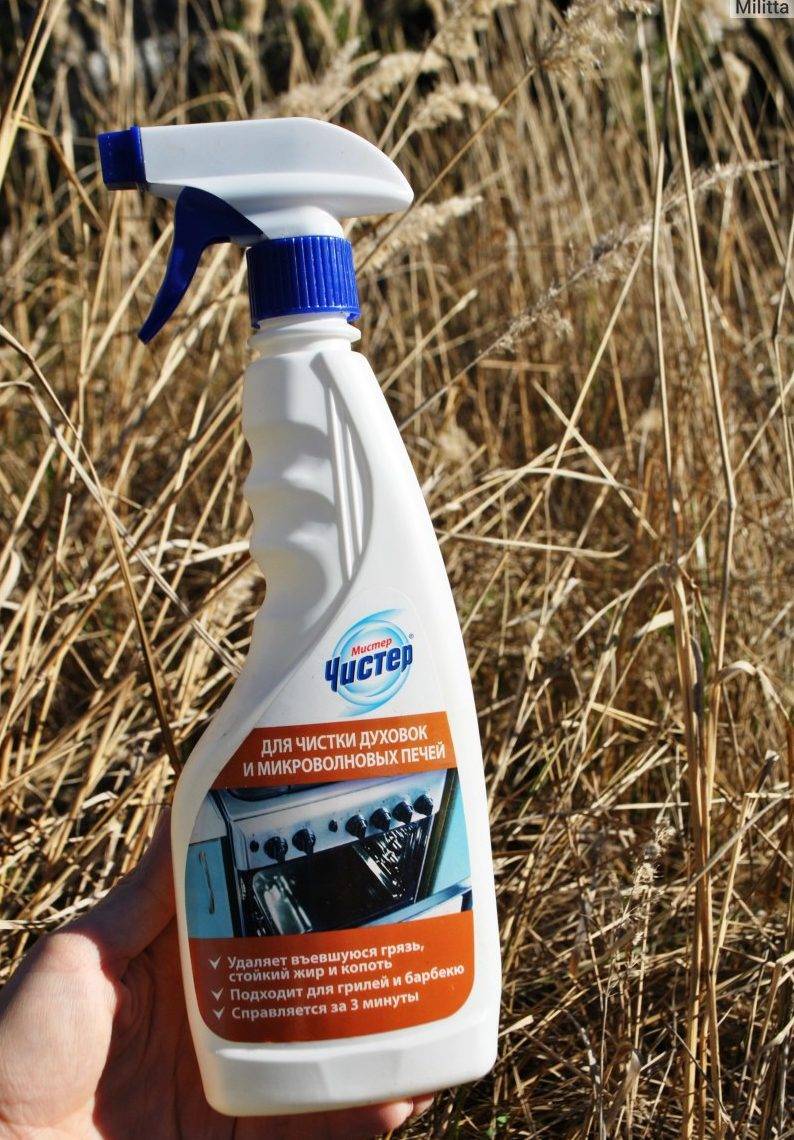
4 "Amway" - universal cleaners that do not wash off the concentrate. After applying the gel, wait a few minutes and wipe with a dry cloth. Has a pleasant aroma and allows you to do procedures without gloves. But the cost is high, and still not washing off the concentrate is scary, it is better to wash everything with liquid.


